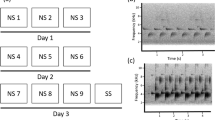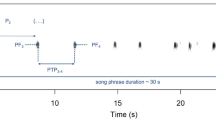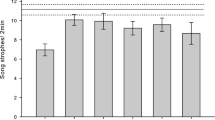Abstract
Many territorial animals are less aggressive towards neighbours than to strangers, a phenomenon known as the ‘dear enemy effect’. However, there has been little research on changes in this behaviour in songbirds across the breeding season. In this study, we followed changes in the dear enemy effect during the breeding season in Great Tits, Parus major. We simulated neighbour and stranger intrusions at three breeding stages corresponding to key ecological and social situations, egg-laying, incubation and nestling stages, and examined the territorial songs and physical responses of territory owners. Our results suggest that neighbours are dear enemies in the egg-laying and incubation stages, when territories are stable, but not at the nestling stage when territories become unstable. In addition, physical responses were more effective as warning signals than territorial songs when dear enemy effects were expressed. We conclude that the dear enemy effect is expressed flexibly, rather than in a fixed way, by territorial male Great Tits in our study area.
Zusammenfassung
Männliche Kohlmeisen (Parus major) stimmen die Ausprägung des „Lieber-Feind-Effekts“ auf das Brutstadium ab
Viele territoriale Tiere sind gegenüber Nachbarn weniger aggressiv als gegenüber fremden Artgenossen, ein Phänomen, das als „Lieber-Feind-Effekt“ bekannt ist. Allerdings haben nur wenige Studien untersucht, inwieweit sich dieser Effekt im Laufe der Brutsaison verändert. In der vorliegenden Studie haben wir Veränderungen im „Lieber-Feind-Effekt“ im Laufe der Brutsaison bei Kohlmeisen, Parus major, untersucht. Wir haben das Eindringen von Nachbarn und fremden Tieren ins Revier simuliert, in drei verschiedenen Brutstadien, die entscheidenden ökologischen und sozialen Situationen entsprechen, nämlich Lege-, Bebrütungs- und Nestlingsstadium, und haben die Reviergesänge und körperlichen Antworten von Revierinhabern untersucht. Unsere Ergebnisse deuten darauf hin, dass Nachbarn während des Lege- und Bebrütungsstadiums, wenn die Reviergrenzen stabil sind, als „liebe Feinde“ betrachtet werden, nicht jedoch während des Nestlingsstadiums, wenn die Reviergrenzen instabil werden. Außerdem waren körperliche Antworten effektivere Warnsignale als Reviergesänge, wenn der „Lieber-Feind-Effekt“ zum Ausdruck gebracht wurde. Wir schlussfolgern, dass bei territorialen männlichen Kohlmeisen in unserem Untersuchungsgebiet der „Lieber-Feind-Effekt“ flexibel und nicht starr ausgeprägt ist.


Similar content being viewed by others
References
Akçay Ç, Searcy WA, Campbell SE, Reed VA, Templeton CN, Hardwick KM, Beecher MD (2011) Who initiates extrapair mating in song sparrows? Behav Ecol 23:44–50
Akçay Ç, Swift RJ, Reed VA, Dickinson JL (2013) Vocal kin recognition in kin neighborhoods of western bluebirds. Behav Ecol 24:898–905
Akçay Ç, Anderson RC, Nowicki S, Beecher MD, Searcy WA (2015) Quiet threats: soft song as an aggressive signal in birds. Anim Behav 105:267–274
Amy M, Sprau P, de Goede P, Naguib M (2010) Effects of personality on territory defence in communication networks: a playback experiment with radio-tagged great tits. P Roy Soc B Bio 277:3685–3692
Baker TM, Wilson DR, Mennill DJ (2012) Vocal signals predict attack during aggressive interactions in black-capped chickadees. Anim Behav 84:965–974
Baldassarre DT, Greig EI, Webster MS (2016) The couple that sings together stays together: duetting, aggression and extra-pair paternity in a promiscuous bird species. Biol Lett 12:20151025
Bee MA (2003) A test of the" dear enemy effect" in the strawberry dart-poison frog (Dendrobates pumilio). Behav Ecol Sociobiol 54:601–610
Beletsky LD, Orians GH (1989) Familiar neighbors enhance breeding success in birds. P Nati Acad Sci USA 86:7933–7936
Blakey JK (1994) Genetic evidence for extra-pair fertilizations in a monogamous passerine, the great tit Parus major. Ibis 136:457–462
Booksmythe I, Jennions MD, Backwell PR (2010) Investigating the ‘dear enemy’ phenomenon in the territory defence of the fiddler crab, Uca mjoebergi. Anim Behav 79:419–423
Boucaud ICA, ValÈre PA, Aguirre Smith MLN, Doligez B, Cauchard L, Rybak F, Vignal C (2016) Interactive vocal communication at the nest by parent great tits Parus major. Ibis 158:630–644
Bradley DW, Mennill DJ (2009) Strong ungraded responses to playback of solos, duets and choruses in a cooperatively breeding Neotropical songbird. Anim Behav 77:1321–1327
Briefer E, Rybak F, Aubin T (2008) When to be a dear enemy: flexible acoustic relationships of neighbouring skylarks, Alauda arvensis. Anim Behav 76:1319–1325
Brun J, Epplen J, Strohbach S, Lubjuhn T, Gerken T (1999) Extra-pair paternity in great tits (Parus major)-a long term study. Behaviour 136:1157–1172
Budka M, Osiejuk TS (2014) Individually specific call feature is not used to neighbour-stranger discrimination: the corncrake case. PLoS ONE 9:e104031
Camfield AF (2006) Resource value affects territorial defense by broad-tailed and rufous hummingbirds. J Field Ornithol 77:120–125
Christensen C, Radford AN (2018) Dear enemies or nasty neighbors? Causes and consequences of variation in the responses of group-living species to territorial intrusions. Behav Ecol 29:1004–1013
Courvoisier H, Camacho-Schlenker S, Aubin T (2014) When neighbours are not 'dear enemies' a study in the winter wren, Troglodytes troglodytes. Anim Behav 90:229–235
Cramp S, Perrins CM (1993) Parus major Great tit. Handbook of the birds of europe, the middle east and north africa: the birds of the Western Palearctic. Oxford Univsity Press, Oxford, pp 255–281
Demko AD, Mennill DJ (2018) Male and female signaling behavior varies seasonally during territorial interactions in a tropical songbird. Behav Ecol Sociobiol 72:1–13
Eliassen S, Jørgensen C (2014) Extra-pair mating and evolution of cooperative neighbourhoods. PLoS ONE 9:e99878
Fisher J (1954) Evolution and bird sociality. In: Huxley J, Hardy AC, Ford EB (eds) Evolution as a Process. Allen & Unwin, London, pp 71–83
Fogo BR, Sanches FHC, Costa TM (2019) Testing the dear enemy relationship in fiddler crabs: is there a difference between fighting conspecific and heterospecific opponents? Behav Process 162:90–96
Getty T (1987) Dear enemies and the prisoner's dilemma: why should territorial neighbors form defensive coalitions? Am Zool 27:327–336
Getty T (1989) Are dear enemies in a war of attrition? Anim Behav 37:337–339
Godard R (1993) Tit for tat among neighboring hooded warblers. Behav Ecol Sociobiol 33:45–50
Gong Y, Qin B, Qin YF, Sun W, Wang HT (2020) Playback of male song advanced onset of nest building but not initial egg date or breeding synchrony in the great tit Parus major. J Ornithol 161:585–588
Gorissen L, Gorissen M, Eens M (2006) Heterospecific song matching in two closely related songbirds (Parus major and P. caeruleus): great tits match blue tits but not vice versa. Behav Ecol Sociobiol 60:260–269
Grabowska-Zhang AM, Sheldon BC, Hinde CA (2012) Long-term familiarity promotes joining in neighbour nest defence. Biol Lett 8:544–546
Gullberg A, Tegelstrom H, Gelter HP (1992) DNA fingerprinting reveals multiple paternity in families of great and blue tits (Parus major and P. caeruleus). Hereditas 117:103–108
Hill SD, Brunton DH, Anderson MG, Ji W (2018) Fighting talk: complex song elicits more aggressive responses in a vocally complex songbird. Ibis 160:257–268
Itzkowitz M, Leiser J (1999) The benefits of dear enemy recognition in three-contender convict cichlid (Cichlasoma nigrofasciatum) contests. Behaviour 136:983–1003
Kerbs JR (1971) Territory and breeding density in the great tit, Parus major L. Ecology 52:2–22
Kolesnikova Y, Liu M, Kang Z, Opaev A (2019) Song does not function as a signal of direct aggression in two Leaf-warbler species. Ornithol Sci 18:17–26
Lachish S, Goldizen AW (2004) Responses to neighbours and non-neighbours in the buff-banded rail (Gallirallus philippensis): no dear-enemy relationships. Aust J Zool 52:369–378
Lesbarrèresa D, Lodé T (2002) Variations in male calls and responses to an unfamiliar advertisement call in a territorial breeding anuran, Rana dalmatina: evidence for a "dear enemy" effect. Ethol Ecol Evol 14:287–295
López JS-L, Gómez JMG, Mennill DJ (2016) Divergence in mating signals correlates with genetic distance and behavioural responses to playback. J Evol Biol 29:306–318
Losin N, Drury JP, Peiman KS, Storch C, Grether GF (2016) The ecological and evolutionary stability of interspecific territoriality. Ecol Lett 19:260–267
Lovell SF, Lein MR (2004) Neighbor-stranger discrimination by song in a suboscine bird, the alder flycatcher, Empidonax alnorum. Behav Ecol 15:799–804
Maciej P, Patzelt A, Ndao I, Hammerschmidt K, Fischer J (2013) Social monitoring in a multilevel society: a playback study with male Guinea baboons. Behav Ecol Sociobiol 67:61–68
McGregor PK, Avery MI (1986) The unsung songs of great tits (Parus major): learning neighbours' songs for discrimination. Behav Ecol Sociobiol 18:311–316
Moser-Purdy C, Mennill DJ (2016) Large vocal repertoires do not constrain the dear enemy effect: a playback experiment and comparative study of songbirds. Anim Behav 118:55–64
Moser-Purdy C, MacDougall-Shackleton EA, Mennill DJ (2017) Enemies are not always dear: male song sparrows adjust dear enemy effect expression in response to female fertility. Anim Behav 126:17–22
Müller CA, Manser MB (2007) 'Nasty neighbours' rather than 'dear enemies' in a social carnivore. P Roy Soc B Bio 274:959–965
Naguib M, Kazek A, Schaper SV, Van Oers K, Visser ME (2010) Singing activity reveals personality traits in great tits. Ethology 116:763–769
Newey PS, Robson SKA, Crozier RH (2010) Weaver ants Oecophylla smaragdina encounter nasty neighbors rather than dear enemies. Ecology 91:2366–2372
Osborne L (2005) Rival recognition in the territorial tawny dragon (Ctenophorus decresii). Acta Ethol 8:45–50
Peake T, Terry AMR, McGregor PK, Dabelsteen T (2001) Male great tits eavesdrop on simulated male–to–male vocal interactions. P Roy Soc Lond B Bio 268:1183–1187
Perneger TV (1998) What's wrong with Bonferroni adjustments. Brit Med J 316:1236–1238
Pratt AE, McLain DK (2006) How dear is my enemy: intruder-resident and resident-resident encounters in male sand fiddler crabs (Uca pugilator). Behaviour 143:597–617
Ritschard M, van Oers K, Naguib M, Brumm H (2012) Song amplitude of rival males modulates the territorial behaviour of great tits during the fertile period of their mates. Ethology 118:197–202
Rosell F, Bjørkøyli T (2002) A test of the dear enemy phenomenon in the Eurasian beaver. Anim Behav 63:1073–1078
Sandoval L (2011) Male–male vocal interactions in a territorial neotropical quail: which song characteristics predict a territorial male's response? Behaviour 148:1103–1120
Searcy WA, Akçay C, Nowicki S, Beecher MD (2014) Aggressive signaling in song sparrows and other songbirds. In: Naguib M, Barrett L, Brockmann HJ, et al. (eds) Advances in the study of behavior. Academic Press, Burlington, pp 89–125
Siracusa ER, Boutin S, Dantzer B, Lane JE, Coltman DW, McAdam AG (2019) Familiar neighbors, but not relatives, enhance fitness in a territorial mammal. bioRxiv.https://doi.org/10.1101/589002:589002
Slagsvold T, Dale S, SÆTRE G-P (1994) Dawn singing in the great tit (Parus major): mate attraction, mate guarding, or territorial defence? Behaviour 131:115–138
Snijders L, van der Eijk J, van Rooij EP, De Goede P, van Oers K, Naguib M (2015) Song trait similarity in great tits varies with social structure. PLoS ONE 10:e0116881
Stoddard PK (1996) Vocal recognition in territorial passerines. In: Kroodsma DE, Miller EH (eds) Ecology and evolution of acoustic communication in birds. Cornell Univ Press, Ithaca, pp 356–374
Strohbach S, Curio E, Bathen A, Epplen J, Lubjuhn T (1998) Extrapair paternity in the great tit (Parus major): a test of the "good genes" hypothesis. Behav Ecol 9:388–396
Szymkowiak J, Kuczyński L (2017) Song rate as a signal of male aggressiveness during territorial contests in the wood warbler. J Avian Biol 48:275–283
Temeles EJ (1989) The effect of prey consumption on territorial defense by harriers: differential responses to neighbors versus floaters. Behav Ecol Sociobiol 24:239–243
Temeles EJ (1994) The role of neighbours in territorial systems: when are they 'dear enemies'? Anim Behav 47:339–350
Wei M, Lloyd H, Zhang Y (2011) Neighbour-stranger discrimination by yellow-bellied Tit Parus venustulus: evidence for the "dear-enemy" effect. J Ornithol 152:431–438
Wilson EO (1975) Sociobiology: the new synthe sis. Harvard Univ. Press, Cambridge
Wood WE, Yezerinac SM (2006) Song sparrow (Melospiza melodia) song varies with urban noise. Auk 123:650–659
Yoon J, Sillett TS, Morrison SA, Ghalambor CK (2012) Breeding density, not life history, predicts interpopulation differences in territorial aggression in a passerine bird. Anim Behav 84:515–521
You YY et al (2009) Variation in egg size and nestling growth rate in relation to clutch size and laying sequence in great tits Parus major. Prog Nat Sci 19:427–433
Zollinger SA, Slater PJB, Nemeth E, Brumm H (2017) Higher songs of city birds may not be an individual response to noise. P Roy Soc B Bio 284:20170602
Zwart MC, Dunn JC, McGowan PJK, Whittingham MJ (2015) Wind farm noise suppresses territorial defense behavior in a songbird. Behav Ecol 27:101–108
Acknowledgements
This research was supported by the National Natural Science Foundation of China (Grant Nos. 31570390, 31770419), and a project funded by China Postdoctoral Science Foundation (2018M631854). We thank Hongwei Xu and Yusheng Wei for their invaluable field assistance. We thank Harry Taylor, PhD, from Liwen Bianji, Edanz Editing China (https://www.liwenbianji.cn/ac), for editing the English text of a draft of this manuscript.
Author information
Authors and Affiliations
Corresponding authors
Ethics declarations
Conflict of interest
We declare there is no conflict of interest.
Additional information
Communicated by F. Bairlein.
Publisher's Note
Springer Nature remains neutral with regard to jurisdictional claims in published maps and institutional affiliations.
Rights and permissions
About this article
Cite this article
Jin, L., Liang, J., Fan, Q. et al. Male Great Tits (Parus major) adjust dear enemy effect expression in different breeding stages. J Ornithol 162, 221–229 (2021). https://doi.org/10.1007/s10336-020-01815-3
Received:
Revised:
Accepted:
Published:
Issue Date:
DOI: https://doi.org/10.1007/s10336-020-01815-3




